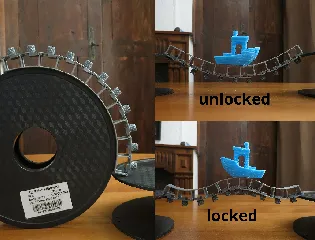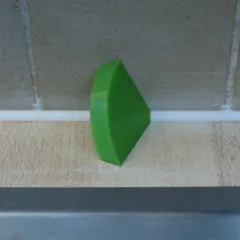Vertical customizable hinge
Description
PDFVersion 2024/03/17
This minor modification fixes a few bugs with low amplitude hinges.
This library features a specific funnel shaped profile for building vertically printable hinges. The hinge appears as a stack of identical knuckles which can be printed easily relying on the overhang capabilities of 3d printers. The hinges must printed in-place and cannot be disassembled. A high torque must be applied initially to separate the knuckles at their tip (or break everything, depending on how aggressive the tolerance settings are).
Vertical printing is interesting as it yields very accurate and smooth hinges with very little play, when tolerances are carefully tuned. The shearing stress along the layers in the inner cylinder is arguably a weakness of this orientation, but the outer cylinder on the opposite is in the best orientation for strong printing, and can be made thinner, which leaves room for a wide inner cylinder. The compact profile also allows a high density of knuckles to multiply the strength, so a decent performance can be achieved overall.
I tried to take into account various configurations regarding the thickness and offset of the leaves, the opening range, and the angle at which the knuckles are linked to the leaves, but I am confident that there are cases that I didn't test and which are not properly handled. I hope that it can still be of some use !
Interface
The hinge module generates a fully assembled hinge with symmetric leaves, ready to print. Alternatively, the two halves can be generated separately with either module leaf or half (the latter allows you to provide a custom shape). It is also possible to use directly the lower-level modules for even more control. See the comments in hinge.scad for more explanation.
Parameters
Many parameters modify the result ofthe hinge module. You can specify not only the knukles count and the leaves dimensions, but also the minimum and maximum opening angle (applying chamfers as appropriate), and also the “join angles” which affect the shape of the link between the knuckles and the leaves.
The dimensions of the profile itself can also be changed, as well as the tolerances, using global variables in hinge.scad. Use include rather than use to be able to modify those.
Tags
Model origin
The author marked this model as their own original creation.




